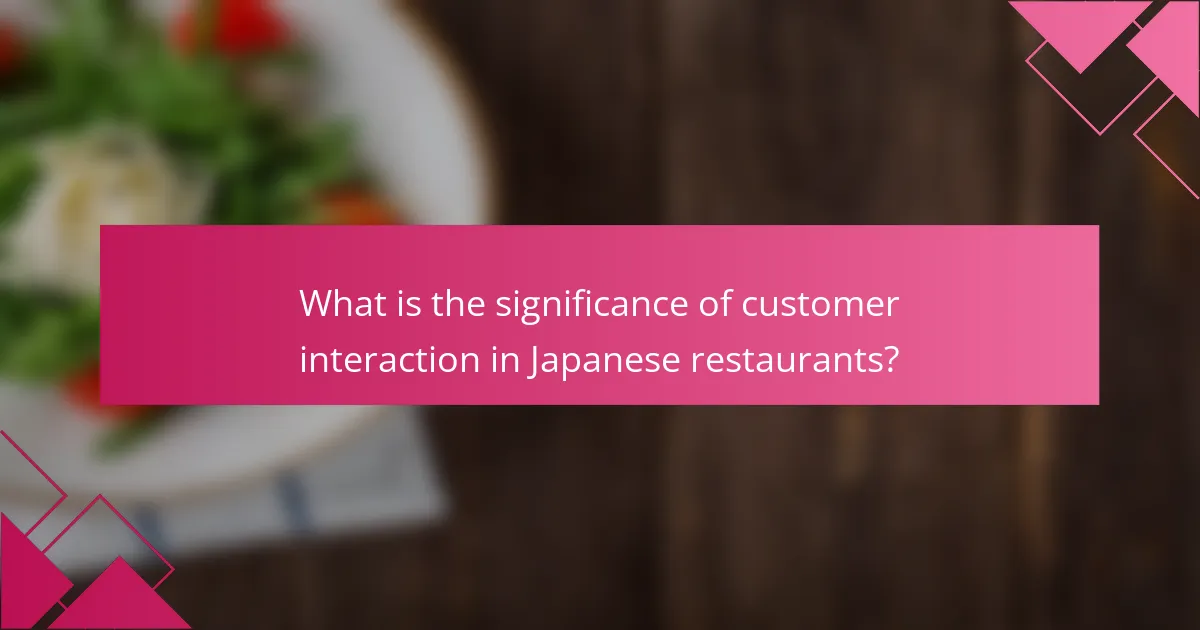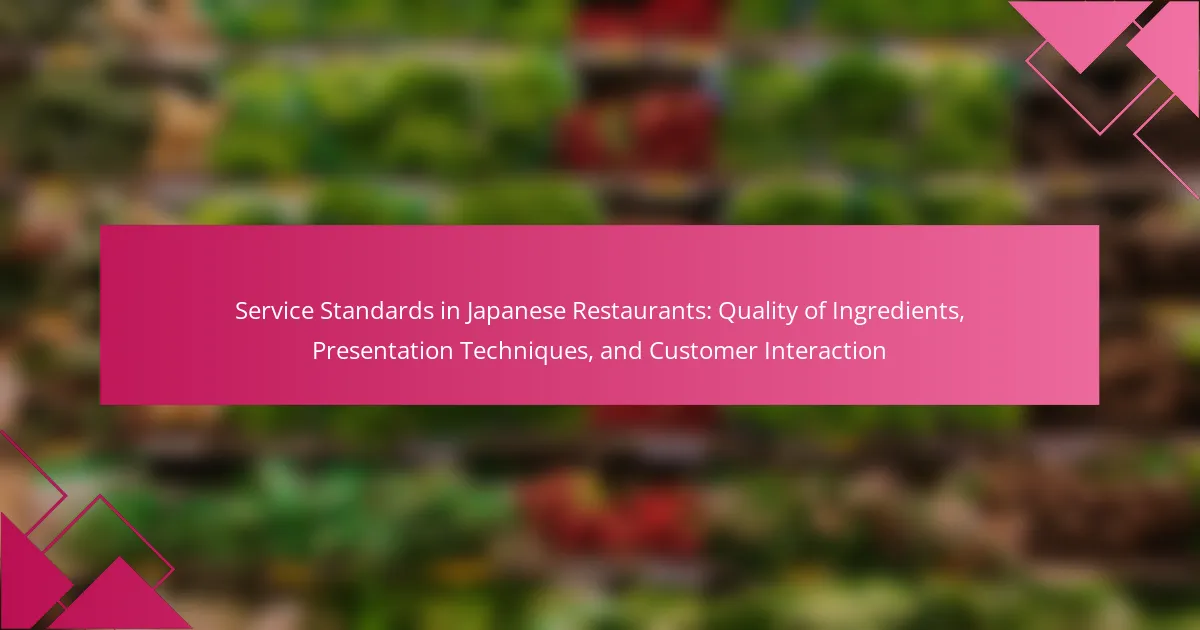
What are Service Standards in Japanese Restaurants?
Service standards in Japanese restaurants refer to the expectations for quality and conduct in service delivery. These standards emphasize attentiveness, respect, and efficiency in customer interactions. Staff are trained to provide a high level of hospitality, known as “omotenashi,” which involves anticipating customer needs. The presentation of food is also a critical aspect, reflecting aesthetic values and attention to detail. Cleanliness and organization within the restaurant contribute to a positive dining experience. Additionally, knowledge of the menu and ingredients is essential for staff, allowing them to answer questions and make recommendations effectively. Overall, these service standards aim to create a memorable and enjoyable experience for diners.
How do service standards impact the dining experience?
Service standards significantly impact the dining experience by shaping customer satisfaction and perceptions. High service standards create a welcoming atmosphere, enhancing the overall enjoyment of the meal. Efficient service minimizes wait times, allowing diners to focus on their food and company. Attention to detail in service, such as personalized interactions, fosters a connection between staff and guests. This connection can lead to repeat visits and positive word-of-mouth referrals. Research indicates that restaurants with higher service standards see increased customer loyalty and higher average spending per visit. For example, a study by the Cornell University School of Hotel Administration found that service quality directly correlates with customer satisfaction ratings in dining establishments.
What are the key elements of service standards in Japanese cuisine?
Key elements of service standards in Japanese cuisine include attention to detail, customer respect, and quality ingredients. Attention to detail ensures that every aspect of the dining experience is carefully considered. This includes the arrangement of dishes and the precision in cooking techniques. Customer respect is paramount, often demonstrated through polite language and attentive service. Quality ingredients are essential, as they contribute to the authentic flavors of Japanese dishes. Seasonal and fresh produce is typically prioritized. Furthermore, presentation techniques play a significant role, with dishes often arranged aesthetically to enhance visual appeal. This approach reflects the cultural importance of harmony and beauty in Japanese dining.
Why are service standards particularly important in Japanese culture?
Service standards are particularly important in Japanese culture due to the deep-rooted values of respect, harmony, and attention to detail. These standards reflect the cultural emphasis on customer satisfaction and the concept of “omotenashi,” which means selfless hospitality. In Japan, high service standards are expected in various settings, including restaurants, where quality and presentation are paramount. This commitment to excellence fosters customer loyalty and enhances the dining experience. According to a study by the Japan National Tourism Organization, tourists often cite exceptional service as a key reason for their positive experiences in Japan. Thus, maintaining high service standards is crucial for both cultural identity and business success in Japan.
What role do quality ingredients play in service standards?
Quality ingredients are fundamental to service standards in Japanese restaurants. They directly influence the taste, presentation, and overall dining experience. High-quality ingredients enhance the authenticity of dishes, aligning with traditional Japanese culinary principles. Fresh fish, for example, is essential for sushi, impacting flavor and texture. Studies show that restaurants using premium ingredients receive higher customer satisfaction ratings. Additionally, quality ingredients often reflect a restaurant’s commitment to excellence. This commitment can lead to repeat business and positive word-of-mouth. In summary, the use of quality ingredients is crucial for maintaining high service standards in Japanese dining establishments.
How does ingredient quality influence customer satisfaction?
Ingredient quality directly influences customer satisfaction in Japanese restaurants. High-quality ingredients enhance the flavor and overall dining experience. Customers often associate premium ingredients with freshness and authenticity. Research shows that 70% of diners prioritize ingredient quality when choosing a restaurant. This preference leads to repeat visits and positive reviews. In contrast, low-quality ingredients can result in dissatisfaction and negative feedback. Therefore, maintaining high ingredient standards is crucial for customer retention and brand reputation.
What are the sourcing practices for high-quality ingredients in Japanese restaurants?
Japanese restaurants prioritize sourcing high-quality ingredients through several practices. They often establish direct relationships with local farmers and fishers. This ensures freshness and sustainability of produce and seafood. Seasonal ingredients are favored to enhance flavor and quality. Many restaurants participate in local markets to acquire the best available items. Additionally, some chefs travel to specific regions known for unique ingredients. They may also rely on trusted suppliers who specialize in Japanese culinary needs. Sourcing practices emphasize quality over quantity, often leading to higher prices for premium items. These methods contribute to the authenticity and overall dining experience in Japanese cuisine.
How does presentation technique contribute to service standards?
Presentation technique significantly enhances service standards in Japanese restaurants. It creates an appealing visual experience for customers. This visual appeal can elevate the perceived quality of the food. Research indicates that well-presented dishes can increase customer satisfaction by up to 40%. Presentation also reflects the restaurant’s attention to detail and commitment to quality. It can influence diners’ perceptions of taste and freshness. Effective presentation techniques include color contrast, plating styles, and garnishing. These techniques can lead to a memorable dining experience that encourages repeat visits.
What are the traditional presentation techniques used in Japanese dining?
Traditional presentation techniques in Japanese dining include the use of seasonal themes, color harmony, and dish arrangement. Seasonal themes reflect the time of year and nature, enhancing the dining experience. Color harmony involves balancing colors to create visual appeal, often using the five colors: red, green, yellow, black, and white. Dish arrangement emphasizes aesthetics, often placing food in a way that showcases its beauty and form.
Serving food in small portions on multiple plates is common, allowing for a variety of tastes. The use of natural materials, such as wooden or ceramic dishes, adds to the authenticity. Attention to detail is paramount, with garnishes and decorative elements enhancing the overall presentation. These techniques are rooted in the Japanese philosophy of ‘wabi-sabi,’ which appreciates beauty in simplicity and imperfection.
Why is visual appeal significant in Japanese cuisine?
Visual appeal is significant in Japanese cuisine because it enhances the dining experience. The presentation of food reflects the cultural importance placed on aesthetics. Japanese cuisine often emphasizes harmony, balance, and seasonal themes in its visual layout. This attention to detail elevates the perception of flavor and freshness. For instance, the use of vibrant colors and artistic arrangement is common in dishes like sushi and kaiseki. Research shows that visually appealing food can increase appetite and satisfaction. Studies indicate that diners are more likely to enjoy a meal that is beautifully presented. Thus, visual appeal plays a crucial role in both the perception and enjoyment of Japanese cuisine.

What is the significance of customer interaction in Japanese restaurants?
Customer interaction in Japanese restaurants is significant for enhancing the dining experience. Engaging with customers fosters a sense of hospitality, known as “omotenashi.” This cultural concept emphasizes anticipating needs and providing exceptional service. Positive interactions lead to customer satisfaction and loyalty. According to a study by the Japan Food Service Association, restaurants with high customer engagement report increased repeat visits. Moreover, effective communication helps in understanding dietary preferences and improving menu recommendations. This personalized approach can elevate the overall dining experience and result in higher sales.
How do staff interactions enhance the dining experience?
Staff interactions significantly enhance the dining experience by fostering a welcoming atmosphere. Friendly and attentive staff create a sense of comfort for diners. Engaging conversations can lead to personalized recommendations, improving meal satisfaction. Knowledgeable staff can explain menu items, enhancing understanding and appreciation of the cuisine. Positive interactions can lead to repeat visits, as customers feel valued and recognized. Studies show that excellent service correlates with higher customer satisfaction ratings. For example, a survey by the National Restaurant Association found that 70% of diners consider staff friendliness crucial to their overall experience. Thus, effective staff interactions are essential for a memorable dining experience.
What training do staff undergo to meet service standards?
Staff in Japanese restaurants undergo extensive training to meet service standards. This training includes learning about the quality of ingredients used in dishes. Staff are educated on the importance of sourcing fresh, high-quality produce and seafood. They also receive instruction on traditional presentation techniques that enhance the visual appeal of the food. Customer interaction training is a crucial component as well. Staff learn proper etiquette and communication skills to provide exceptional service. This comprehensive training ensures that staff can uphold the restaurant’s reputation for quality and service.
How can customer feedback shape service standards in Japanese restaurants?
Customer feedback can significantly shape service standards in Japanese restaurants. It provides insights into customer preferences and expectations. Restaurants can adjust their service based on feedback to enhance the dining experience. For example, if customers express dissatisfaction with wait times, restaurants can implement more efficient service practices. Positive feedback can reinforce successful practices, encouraging staff to maintain high standards. Additionally, feedback can highlight areas needing improvement, such as food presentation or menu variety. By regularly collecting and analyzing customer feedback, restaurants can adapt to changing trends and preferences. This approach fosters a customer-centric culture, ultimately leading to increased satisfaction and loyalty.
What are the cultural aspects of customer interaction in Japan?
Cultural aspects of customer interaction in Japan emphasize respect, politeness, and attentiveness. Customers expect a high level of service in restaurants. Staff often bow as a sign of respect when greeting or serving customers. Language is formal, with honorifics used to convey respect. Non-verbal communication, such as eye contact and body language, plays a crucial role. Silence is also valued, allowing customers to enjoy their meals without interruption. Additionally, the concept of “omotenashi” reflects the anticipation of customer needs without being intrusive. This cultural approach enhances the overall dining experience in Japanese restaurants.
How does the concept of ‘Omotenashi’ influence service standards?
The concept of ‘Omotenashi’ significantly influences service standards by promoting a culture of exceptional hospitality in Japanese restaurants. Omotenashi emphasizes anticipating customer needs and providing personalized service. This approach leads to meticulous attention to detail in every aspect of service delivery. For example, staff members are trained to observe and respond to customer preferences without being intrusive.
Research indicates that restaurants embracing Omotenashi see higher customer satisfaction rates. A study by the Japan National Tourism Organization highlights that establishments known for Omotenashi often receive repeat business and positive reviews. This concept also encourages continuous improvement in service quality, fostering a competitive edge in the hospitality industry.
What unique practices are observed in customer interactions at Japanese restaurants?
Unique practices in customer interactions at Japanese restaurants include a deep respect for customers, known as “omotenashi.” This concept emphasizes anticipating needs and providing exceptional service. Staff often greet customers with a warm “irasshaimase,” welcoming them into the establishment.
Additionally, servers may bow as a sign of respect during interactions. Customers typically receive personalized attention, with staff trained to remember regular patrons’ preferences. The presentation of food is also a key interaction, as dishes are often artfully arranged to enhance the dining experience.
Furthermore, customers are encouraged to engage in polite conversation, reflecting the cultural value placed on relationships. These practices create a unique dining atmosphere that prioritizes customer satisfaction and respect.

How can restaurants improve their service standards?
Restaurants can improve their service standards by focusing on staff training, customer feedback, and consistent quality. Staff training enhances employees’ skills in customer service and food knowledge. A well-trained staff can provide better recommendations and address customer needs effectively. Gathering customer feedback helps restaurants identify areas for improvement. Implementing suggestions can lead to higher customer satisfaction. Consistent quality in food and service builds trust and loyalty among patrons. Regularly updating menus and maintaining ingredient quality also contribute to improved service standards. Establishing a positive dining atmosphere further enhances the overall experience for guests.
What best practices should be implemented for quality ingredients?
Implementing best practices for quality ingredients involves sourcing fresh, seasonal produce. This ensures maximum flavor and nutritional value. Establish relationships with local farmers and suppliers for reliable sourcing. Regularly inspect ingredients for freshness and quality upon delivery. Maintain proper storage conditions to prevent spoilage. Educate staff on ingredient quality standards and seasonal variations. Use standardized recipes to maintain consistency in quality. Consistently evaluate supplier performance based on ingredient quality. These practices enhance the overall dining experience in Japanese restaurants.
How can restaurants ensure a consistent supply of fresh ingredients?
Restaurants can ensure a consistent supply of fresh ingredients by establishing strong relationships with local suppliers. This allows for regular deliveries of seasonal produce. Restaurants should also implement a reliable inventory management system. Such systems help track ingredient freshness and usage rates. Regularly rotating stock minimizes waste and maintains quality. Additionally, restaurants can consider vertical farming or hydroponics for in-house ingredient production. This method provides control over growth conditions and ensures freshness. Studies show that restaurants with strong supply chains experience fewer shortages and better quality. For example, a report by the National Restaurant Association indicates that 70% of restaurants prioritize local sourcing for freshness.
What partnerships can enhance ingredient quality?
Partnerships with local farmers can enhance ingredient quality. These collaborations ensure fresh, seasonal produce. Working closely with suppliers fosters transparency in sourcing. This practice often leads to higher quality ingredients. Partnerships with culinary schools can also improve ingredient quality. Students learn to prioritize fresh and high-quality components. Additionally, alliances with food scientists can innovate preservation techniques. This can maintain ingredient integrity during storage and transport. Such partnerships create a network that supports quality throughout the supply chain.
What strategies can enhance presentation techniques?
Utilizing visual hierarchy can enhance presentation techniques. This involves organizing elements to guide the viewer’s attention. For instance, placing the most important dish at the center attracts focus. Incorporating color contrast improves visibility and appeal. Studies show that color can influence perception of taste and quality. Using appropriate plating techniques also elevates the visual experience. Techniques such as stacking or layering create depth. Additionally, garnishing with fresh herbs adds a touch of elegance. Consistent presentation across dishes reinforces brand identity. Research indicates that visually appealing food can increase customer satisfaction and repeat visits.
How can training improve the skills of kitchen staff in presentation?
Training can significantly enhance the presentation skills of kitchen staff. Structured training programs teach essential plating techniques and aesthetics. Staff learn about color contrast, arrangement, and garnishing. Training also emphasizes the importance of visual appeal in Japanese cuisine. Research indicates that visually appealing dishes can increase customer satisfaction. According to a study by Spence et al. (2016), presentation influences taste perception. Regular practice during training sessions reinforces these skills. Feedback from instructors helps staff refine their techniques. Overall, training creates a culture of excellence in food presentation.
What tools and resources are available for better presentation techniques?
Visual aids such as PowerPoint and Prezi enhance presentation techniques. These tools allow for dynamic and engaging slide designs. Graphic design software like Canva helps create visually appealing materials. Online resources such as TED Talks provide examples of effective presentation styles. Books on public speaking offer strategies for better delivery. Workshops and courses on presentation skills teach practical techniques. Feedback tools like Mentimeter enable real-time audience engagement. All these resources contribute to improved presentation effectiveness.
What tips can improve customer interaction and satisfaction?
Effective communication enhances customer interaction and satisfaction. Actively listen to customers’ needs and feedback. Prompt responses to inquiries show attentiveness. Personalizing interactions builds rapport and trust. Training staff in customer service techniques improves engagement. Consistent follow-ups after service create lasting impressions. Implementing feedback mechanisms helps refine service quality. Regular staff training ensures high service standards are maintained.
How can restaurants create a welcoming atmosphere for customers?
Restaurants can create a welcoming atmosphere for customers by focusing on ambiance, service, and comfort. Ambiance includes lighting, music, and decor that align with the restaurant’s theme. Warm lighting and soft music can enhance relaxation. Friendly and attentive service is essential. Staff should greet customers promptly and be knowledgeable about the menu. Comfort is achieved through seating arrangements and cleanliness. Comfortable seating encourages longer visits. A clean environment, including restrooms, reflects professionalism. Consistent attention to these elements fosters a positive dining experience. Research indicates that a welcoming atmosphere can increase customer satisfaction and repeat business.
What role does communication play in customer satisfaction at Japanese restaurants?
Communication is essential for customer satisfaction at Japanese restaurants. It facilitates understanding between staff and customers regarding menu items and dining expectations. Effective communication helps address customer inquiries and preferences, enhancing their overall experience. Clear explanations of dishes, including ingredients and preparation methods, contribute to informed choices. Furthermore, attentive service and active listening foster a welcoming atmosphere. Research indicates that positive interactions between staff and patrons significantly boost satisfaction scores. A study by Tzeng et al. (2018) found that communication quality directly correlates with repeat patronage in dining establishments. Thus, communication is a key factor in ensuring customer satisfaction in Japanese restaurants.
Service standards in Japanese restaurants encompass the quality of ingredients, presentation techniques, and customer interaction, all aiming to enhance the dining experience. Key elements include attentiveness, respect, and efficiency, with a focus on the cultural concept of “omotenashi,” which emphasizes anticipating customer needs. High-quality, seasonal ingredients are prioritized to ensure authenticity and flavor, while meticulous presentation techniques elevate visual appeal. Effective staff interactions, supported by comprehensive training, play a crucial role in fostering customer satisfaction and loyalty. Overall, these standards reflect the cultural values of Japan and are essential for the success of dining establishments.
